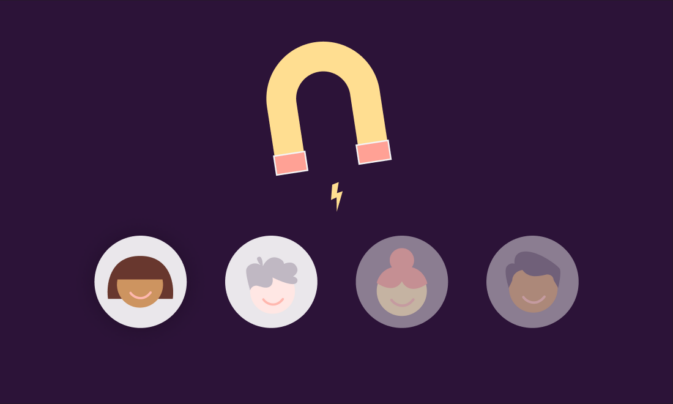As a recruiter or part of the HR department, you are challenged with the unique task of finding the best talent for your organization.
You already know that conducting an effective recruitment process is key to the success and growth of a business, but are you completely utilizing the full recruitment cycle?
Full cycle recruitment, also referred to as full life cycle recruitment or end-to-end recruiting, usually begins with the posting of a job vacancy, followed by interviews, screenings, and assessments of potential hires in order to select the final candidate, and ends with a successful onboarding candidate experience.
Then starting all over again and continuously optimizing every step of the way.
If that sounds like a lot, don’t worry, we’re here to help! In this article, we’ll cover all the bases of life cycle recruiting as we dive into:
- Defining full life cycle recruiting
- What is on-cycle recruiting?
- Who uses full cycle recruiting and why
- Who is responsible for full-cycle recruiting
- The 6 stages of full life cycle recruiting
- 5 Things a good full cycle recruiter should be doing
- And, finally, how we make full-cycle recruitment easier for you
What is full cycle recruiting – and how does it benefit hiring?
Full cycle recruiting is a complete end-to-end process that is rounded off with the candidate accepting the job offer and becoming a new (and happy) employee. It includes every step in the recruitment process, from creating and posting a job description to advertising the opening, screening candidates, performing background checks, and, finally, onboarding the candidate.
The full-cycle recruiting approach includes a number of advantages for hiring managers and companies, namely:
- Easier and faster turnaround time when hiring new employees, as one person is responsible for all aspects of the process.
- Better qualified candidates – especially for hard-to-fill roles – as the recruiter better understands the company and candidate needs.
- Significant increase in consistency during the hiring process, as all candidates will be evaluated using the same criteria.
- Increased accountability for the success of the hiring process, as the recruiting team is responsible for all aspects of the process.
- Better candidate experience as the recruiter is able to provide 360 feedback throughout the process while building a meaningful relationship.
- The right role and culture fit – greater likelihood of hiring the ideal candidate who fits both the role and the company culture.
🤔 Still not convinced? Here are a few business cases that highlight some of the full recruiting cycle benefits for hiring managers:
- Quality candidates – Companies can better control the quality of candidates by managing the full recruitment process in-house.
- Productive workforce – Top talent can lead to a more productive and engaged workforce, positively impacting team morale.
- Leaner company finances – A strong and efficient recruitment process can positively affect the company’s bottom line.
- Attract top talent – A robust recruitment process can aid in acquiring the best talent.
- Reduce turnover costs – Good recruiting can help decrease the costs associated with high turnover rates.
What does on cycle recruiting mean – and how is it different?
On cycle recruiting is the process of filling open positions within a specified time frame or hiring cycle. It is typically used to fill positions that are part of an organization’s regular staffing needs.
On the other hand, full-cycle recruiting covers the entire process of identifying, sourcing, evaluating, and hiring candidates. This includes both on cycle and off-cycle recruiting, as well as any other activities related to finding qualified candidates for open positions.
Additionally, full-cycle recruiting can also include efforts to fill positions outside of the regular staffing needs, such as temporary or contract positions.
Who uses the full life cycle recruiting process – and why?
Full life cycle recruiting is used by a wide range of companies from startups to corporate entities across various industries. The full life cycle recruiting process can either be done in-house or by using an agency.
- In-house recruiters have a deep understanding of the company’s culture, policies, and needs, and can easily align full life cycle recruiting with the company’s objectives.
- An agency, on the other hand,might be more cost-effective and allows recruiters to focus on other key HR tasks while the agency handles the entire recruitment process.
- Small and medium-sized companies often use full-cycle recruiting because they may not have the resources or volume to have separate specialists for each stage of the recruitment process.
- For larger organizations, it is common to have a dedicated full cycle recruiter, who is responsible for managing the entire recruitment process.
However, full cycle recruiting may not be the best approach for all situations, such as when a company’s hiring volume has drastically increased.
In this case, it may be more efficient to split the recruitment process between multiple recruiters or teams to ensure that the talent acquisition happens in a timely manner.
Who is responsible for full-cycle recruiting?
The full-cycle recruiting process is usually the job of one recruiter, especially in small to medium-sized HR departments. In larger organizations, the responsibility might be shared among various relevant departments and personnel, but the HR department is the one that leads and oversees each step.
Regardless of whether or not your company has a dedicated full-cycle recruiter on board, it’s not unusual for other departments or personnel to take part in the recruiting process. In fact, you may just be one of those people – roped into looking at resumes or taking part in interviews – since you will have an invaluable opinion on the requirements and duties for the role.
What are the main stages of full life cycle recruiting?
The six stages – or main stages as some call them – of full life cycle recruiting include preparing, sourcing, screening, selecting, hiring, and onboarding a new hire. This comprehensive hiring process may use both on and off-cycle recruiting, as well as any other activities that are related to finding and hiring the ideal candidate.

Let’s take a closer look at each step.
1. Job Analysis and Preparation
This first stage involves identifying the skills and experience that candidates should possess in order to be successful in the position. This may include conducting a job analysis to determine the duties and responsibilities of the role and creating job descriptions that outline the requirements and qualifications for the position.
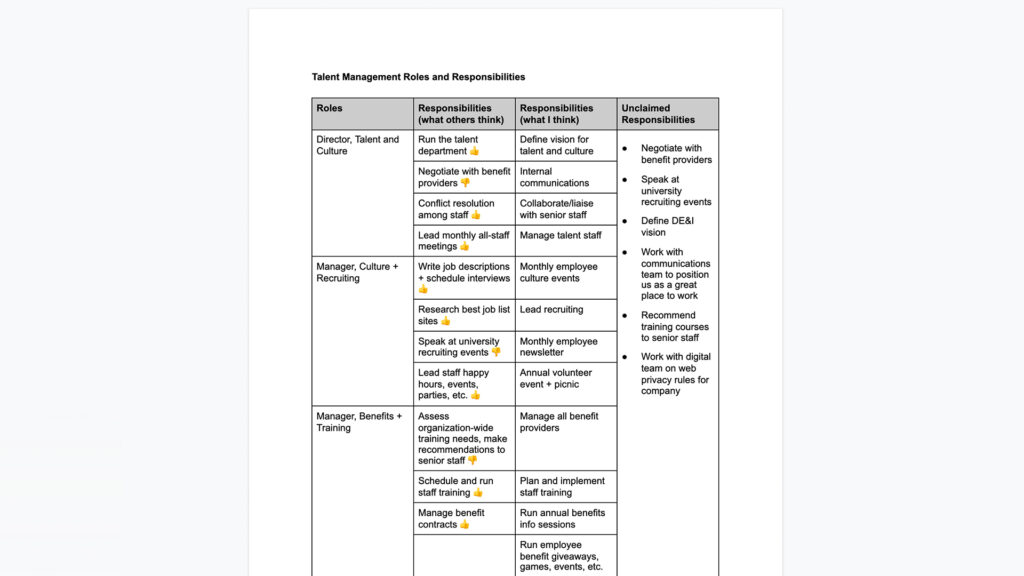
2. Sourcing and Attracting
The second stage of full-cycle recruiting involves attracting qualified candidates from the talent pool to the organization. This may involve using various sourcing techniques, such as job boards, employee referrals, social media, and targeted recruiting campaigns.
3. Evaluating and Screening step
Once potential candidates have been identified, the next stage is to screen and evaluate their qualifications and fit for the role. This may involve reviewing resumes and cover letters, conducting phone or video interviews, and using assessments or other evaluation tools.
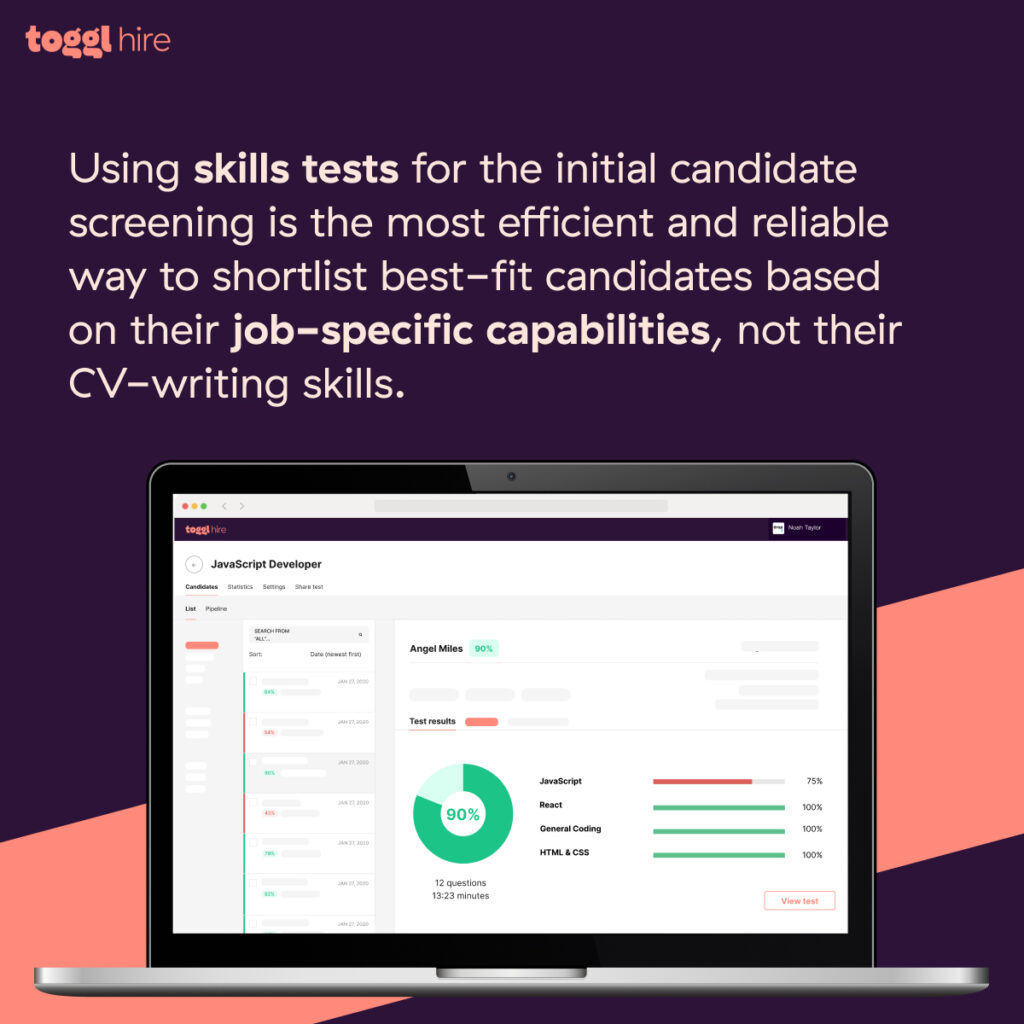
4. Interview and Selecting
The next step in the full recruitment life cycle involves conducting in-person or virtual interviews with top candidates to narrow down the selection process. Interviewing candidates is an essential step for almost every role to help evaluate the candidate’s hard and soft skills and potential fit.
5. Offer, Negotiation, and Hiring
Once a candidate has been selected, a job offer is made, which might include a bit of negotiation. At this crucial stage, it is common for an organization to conduct background and reference checks to verify their qualifications and employment history.
6. Onboarding
Finally, after a candidate has accepted a position, the final stage of full cycle recruiting is the onboarding process, which involves introducing the new hire to the team and getting him up to speed on his new role.
5 Things a good full cycle recruiter should be doing
As a full-cycle recruiter, it is important to have the know-how and resources to be able to manage every stage of the recruitment process effectively. Here are five things that a good full-cycle recruiter should be doing to ensure success:
1. Source candidates with effective techniques and strategies
A good full-cycle recruiter must identify and attract quality talent through the right sourcing techniques for the role, whether that’s through a mix of job boards, employee referrals, social media, targeted recruiting campaigns, or all of the above.
2. Utilize evaluation and screening tools
There is a wide range of tools available to better evaluate and screen candidates (like Toggl Hire.) Using best-in-class hiring tools not only helps ensure that they possess the necessary qualifications and skills for the role, but can also help save critical time (and money!)
3. Make unbiased hiring decisions
It’s important to be aware of bias and its potential influence in order to make informed and unbiased hiring decisions. This starts from the messaging in your job ad and the information you request, all the way to hiring decisions based on the evaluation and screening process.
4. Implement a smooth and effective onboarding process
According to Harvard Business Review, companies that have a formal onboarding program experience up to 50% greater employee retention rates. A smooth and effective onboarding process for new hires should include introducing them to the organization and all the help they need to perform their new job successfully.
5. Prioritize and optimize each stage of the process
Optimization should be ongoing in order to ensure that your end-to-end recruitment is as efficient and effective as possible. This includes taking into account feedback and input from candidates and colleagues in order to fine-tune the life cycle recruiting process. As well as effectively managing each stage using various sourcing techniques, evaluation tools, and onboarding strategies to find, attract, and hire the best candidates.
Wrapping up: 6 reasons to consider full-cycle recruiting
To help you understand whether full life cycle recruiting is right for you, here’s a recap of some of the 6 key benefits for full cycle recruiters.
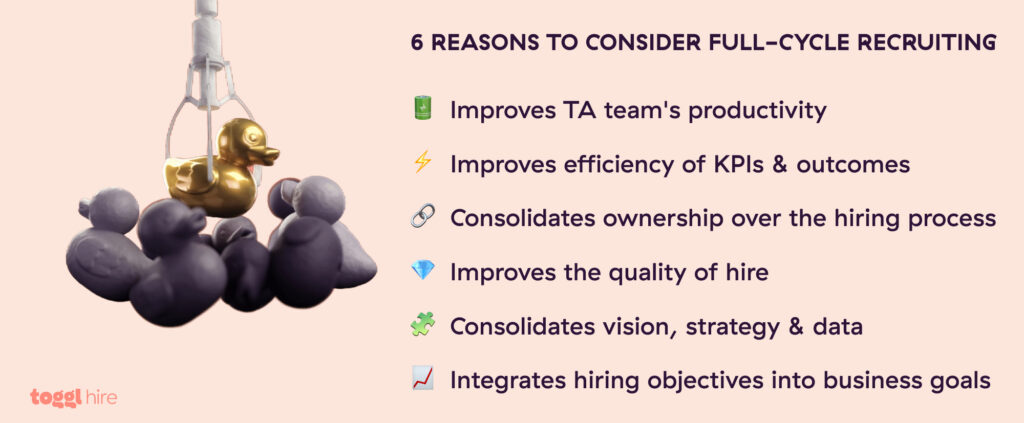
- Improves talent acquisition team’s productivity and the ability to source and retain top talent, which can affect profitability.
- Improves efficiency of a range of KPIs and outcomes, such as reducing time to hire, streamlining the hiring strategy, improving quality of hire, increasing accountability, and improving communication.
- Consolidates ownership over the recruiting process by putting the same person or agency in charge of everything. This ensures a greater sense of control and accountability while eliminating inefficient overlap or potential confusion over who owns each part of the process.
- Improves the quality of hire by standardizing the process for identifying the best candidate for a position and ensuring early alignment between all parties. This process involves a more personalized and thorough approach than traditional recruiting, enabling hires that are better suited to the role and organizational culture.
- Consolidates accountability, vision, strategy, and data into a single entity or role, making it easier to identify missteps or inefficiencies, and a central recruiting vision.
- Integrates hiring objectives into larger business objectives. By having a central recruiting vision aligned with larger business objectives, organizations can ensure that their hiring efforts are in sync.
Full cycle recruitment made simple with Toggl Hire
As a full cycle (or potential full cycle) recruiter, your goal is to make the right hires and set them up for success in the organization. This entails identifying the qualifications and experience a position requires, finding the right candidates, making a hiring decision, and onboarding the successful applicant.
The full-cycle recruiter plays an integral role in achieving organizational goals and providing guidance and support throughout the entire process – yes, you truly are a jack of all trades.
By using Toggl Hire, you can easily cover several steps of the recruitment process at once, saving you a lot of time and effort and thus allowing you to focus on your ideal candidate.
- Screen faster with Skill Tests. Pick from a library of pre-built technical and soft skills assessments, and customize them to match your job requirements.
- Integrate automation. Set up a Pass threshold to create a minimum pass score as the first step in identifying the best potential candidates – have your skills tests graded automatically.
- Run asynchronous intro interviews. Use Video Intros to set up and automate initial candidate screening via video. Create an intro video to give candidates a better understanding of the role and the organization, then pick up to 3 questions from the video question pool and let candidates send in their video answers.
- Distribute homework assignments. Make candidate shortlisting effortless with a data-driven selection process: use take-home assignment templates to evaluate job-specific skills at the later recruitment stages.
- Collect feedback. Keep everyone on the same page with shared notes and candidate ratings to drive better hiring decisions.
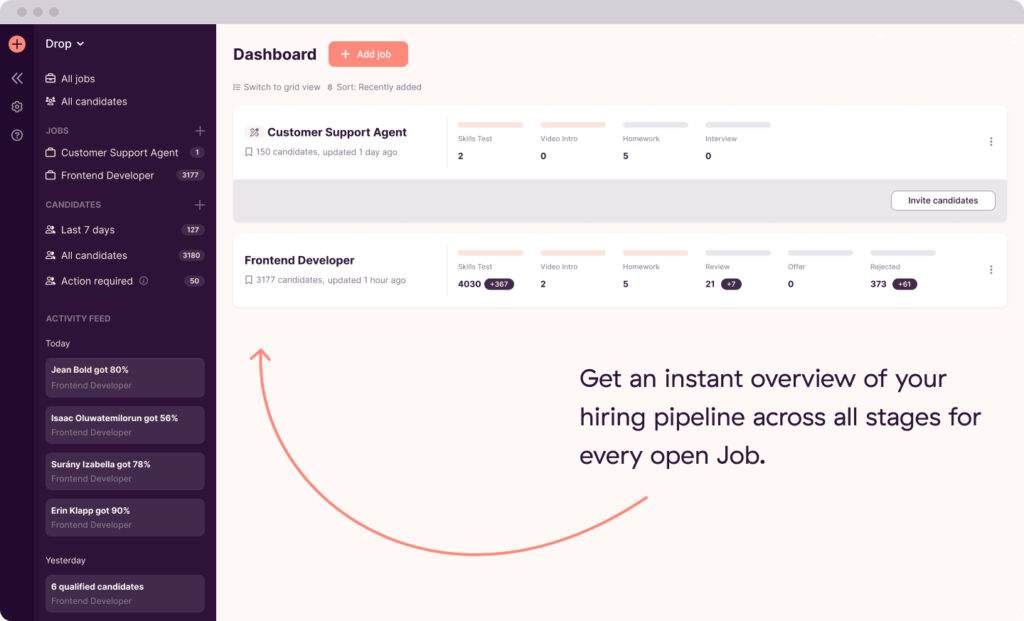 skills-based hiring with Toggl Hire: one recruitment tool for all stages. ” class=”wp-image-37608″/>
skills-based hiring with Toggl Hire: one recruitment tool for all stages. ” class=”wp-image-37608″/>Does that sound exciting to you? Do you need to refine your full life cycle recruitment process? Then check out our free skills-based hiring tool.
Juste loves investigating through writing. A copywriter by trade, she spent the last ten years in startups, telling stories and building marketing teams. She works at Toggl Hire and writes about how businesses can recruit really great people.





